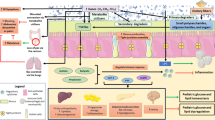Abstract
Objective:
To evaluate dietary fiber intake in children with recurrent abdominal pain.
Design:
Cross-sectional study with control group.
Setting:
Outpatients of the Pediatric Gastroenterology public health clinic of the Darcy Vargas Children's Hospital, Brazil.
Subjects:
Forty-one patients with recurrent abdominal pain were evaluated and 41 children, as a control group.
Interventions:
Macronutrients and fiber intake evaluation by the Daily Food Intake method. Two tables of fiber composition in foods were used.
Results:
According to the Brazilian table the mean intake of fiber (g/day) by the children of the recurrent abdominal pain groups with chronic constipation or not, and the control group was, respectively, 18.2, 16.6 and 23.7 for total fiber (P=0.001), 7.5, 6.9 and 9.5 for soluble fiber (P=0.001) and 10.7, 9.7 and 14.1 for insoluble fiber (P=0.002). According to the AOAC table, the recurrent abdominal pain group with chronic constipation or not (10.6 and 9.9 g/day) also had lower intake of total fiber than the control group (13.4 g/day) (P=0.008). The intake of fiber was lower than the minimum recommended value (age+5 g) and statistically associated (P=0.021) with the recurrent abdominal pain group (78%) in comparison with the control one (51.2%). The odds ratio was 3.39 (95% CI, 1.18–9.95).
Conclusion:
fiber intake below the minimum recommended value is a risk factor for recurrent abdominal pain in children.
This is a preview of subscription content, access via your institution
Access options
Subscribe to this journal
Receive 12 print issues and online access
$259.00 per year
only $21.58 per issue
Buy this article
- Purchase on Springer Link
- Instant access to full article PDF
Prices may be subject to local taxes which are calculated during checkout
Similar content being viewed by others
References
American Dietetic Association (US) (1998). Position of the American Dietetic Association: Health implications of dietary fiber. J Am Diet Assoc 88, 216–221.
Anção MS, Cuppari L, Tdisco ES, Draibe AS, Sigulem D (1995). Sistema de Apoio à Nutrição [computer software program]. Version 2.5 São Paulo (SP): Universidade Federal de São Paulo.
Apley J, Naish N (1958). Recurrent abdominal pains: a field survey of 1000 school children. Arch Dis Child 33, 165–170.
Boyle JT (1997). Recurrent abdominal pain: an update. Pediatr Rev 18, 310–320.
Boyle JT (2000). Abdominal pain. In: Walker Wa, Durie PR, Hamilton JR, Walker-Smith JA (eds). Pediatric gastrointestinal disease. Ontario: BC Decker, pp. 129–149.
Campo JV, Bridge J, Ehmann M, Altman S, Lucas A, Birmaher B et al. (2004). Recurrent abdominal pain, anxiety, and depression in primary care. Pediatrics 113 (4), 817–824.
Christensen MF (1994). Motility in children with recurrent abdominal pain: a controlled study. Acta Paediatr 83, 542–544.
Christensen MF (2004). Rome II classification-the final delimitation of functional abdominal pains in children? J Pediatr Gastroenterol Nutr 39 (3), 303–304.
Croffie JM, Fitzgerald JF, Chong SKF (2000). Recurrent abdominal pain in children – A retrospective study of outcome in a group referred to a pediatric gastroenterology practice. Clin Pediatr 39 (5), 267–274.
Di Lorenzo C, Youssef NN, Sigurdsson L, Scharff L, Griffiths J, Wald A (2001). Visceral hyperalgesia in children with functional abdominal pain. J Pediatr 139 (6), 838–843.
Dimson SB (1972). Transit time related to clinical findings in children with recurrent abdominal pain. Pediatrics 47, 666–674.
Duarte MA, Goulart EM, Penna FJ (2000). Pressure pain threshold in children with recurrent abdominal pain. J Pediatr Gastroenterology Nutr 31 (3), 280–285.
Feldman W, McGrath P, Hodgson C, Ritter H, Shipman RT (1985). The use of dietary fiber in the management of simple, childhood, idiopathic, recurrent abdominal pain. Results in a prospective, double-bind, randomized, controlled trial. Am J Dis Child 139, 1216–1218.
Fox E (1995). Jandel Sigma Stat-statistical software for windows [computer program]. Version 2.0. Germany.
Hansen RG, Wyse BW (1980). Expression of nutrient allowances per 1000 kilocalories. J Am Diet Assoc 76, 223–227.
Hillemeier C (1995). An overview of the effects of dietary fiber on gastrointestinal transit. Pediatrics 96, 997–999.
Huertas-Ceballos A, Macarthur C, Logan S (2002). Dietary interventions for recurrent abdominal pain (RAP) in childhood. Cochrane Database Syst Rev (2), CD003019.
Hunt R, Fedorak R, Frohlich J, Meclennan C, Pavilanis A (1993). Therapeutic role of dietary fiber. Can Fam Phys 39, 897–910.
Hyams JS, Faure C, Gabriel-Martinez E, Maffeu HVL, Morais MB, Hock QS et al. (2002). Functional gastrointestinal disorders: working group report of the first world congress of gastroentero-logy pediatric, hepatology and nutrition. J Pediatr Gastroenterol Nutr 35 (Suppl 2), S110–S117.
Hyams JS, Treem WR, Justinich CJ, Davis P, Shoup M, Burke G (1995). Characterization of symptoms in children with recurrent abdominal pain: resemblance to irritable bowel syndrome. J Pediatr Gastroenterol Nutr 20 (2), 209–214.
Kopel FB, Kim IC, Barbero GJ (1967). Comparison of rectosigmoid motility in normal children, children with recurrent abdominal pai8n, and children with ulcerative colitis. Pediatrics 39, 539–544.
Mendez MHM, Derivi SCN, Rodrigues MCR, Fernandes ML (1992). Tabela de composição de alimentos. Niterói: Editora da Universidade Federal Fluminense. 39p.
Morais MB, Vítolo MR, Aguirre ANC, Fagundes-Neto U (1999). Measurement of low dietary fiber intake as a risk factor for chronic constipation in children. J Pediatr Gastroenterol Nutr 29, 132–135.
National Research Council (US) (1989). Recommended dietary allowances. 10th ed. Washington (DC): National Academy Press.
Nicklas TA, Farris R, Meyers L, Berenson D (1995). Dietary fiber intake of children and young adults: The Bogalusa Heart Study. J Am Diet Assoc 95, 209–214.
Piñeiro-Careiro VM, Andres JM, Davis RH, Mathias JR (1988). Abnormal gastroduodenal motility in children and adolescents with recurrent functional abdominal pain. J Pediatr 113, 820–825.
Rasquim-Weber A, Hyman PE, Cucchiara S, Fleisher DR, Hyams JS, Milla PJ et al. (1999). Childhood functional gastrointestinal disorders. Gut 45 (2), 1160–1168.
Rome E, Dimitris A, Niolara A, Messaritakis C (1999). Diet and chronic constipation in children: the role of fiber. J Pediatr Gastroenterol Nutr 28, 169–174.
Sabioni JG (1989). Métodos de determinação da fibra dietética. Boletim CEPPA 7 (1), 1–16.
Schneeman BO, Tietyen LF (1995). Dietary Fiber. Pediatr Clin North Am 42 (4), 825–838.
Shils ME, Olson JA, Shike M (1994). Dietary fiber content of selected food. In: Shils ME, Olson JA and Shike M (eds). Modern nutrition in health and disease. Philadelphia: Lea & Fibeger, pp. A92–A98.
Slavin JL (1987). Dietary fiber: classification, chemical analysis and food sources. J Am Diet Assoc 87, 1164–1171.
Southgate DAT (1978). Dietary fiber: analysis and food sources. Am J Clin Nutr 31, 107–110.
Spiller RC (1994). Pharmacology of dietary fibre. Pharmacol Ther 62, 407–427.
Stordal K, Nygaard EA, Bentsen B (2001). Organic abnormalities in recurrent abdominal pain in children. Acta Pediatric 90, 638–642.
Thompson FE, Byers T (1994). Dietary assessment resource manual. J Nutr 124 (Suppl), S2245–S2301.
Van Ginkel R, Voskuijl WP, Benninga MA, Taminiau JA, Boeckxstaens GE (2001). Alterations in rectal sensitivity and motility in childhood irritable bowel syndrome. Gastroenterology 120 (1), 31–38.
Vítolo MR, Aguirre NA, Fagundes-Neto U (1998). Estimativa do consumo de fibra alimentar por crianças de acordo com diferentes tabelas de composição de alimentos. Arch Latinoam Nutr 48, 141–145.
Willians CL (1995). Importance of dietary fiber in childhood. J Am Diet Assoc 95 (10), 1132–1149.
World Health Organization (1990). Report of a WHO study group. Diet, nutrition and the prevention of chronic diseases. Tech. Rep. Ser. 797. Geneva: World Health Organization.
Author information
Authors and Affiliations
Corresponding author
Additional information
Guarantors: OMS Amancio and MB de Morais.
Contributors: AZP, OMSA and MBdeM helped in designing and writing up of the study.
Rights and permissions
About this article
Cite this article
Paulo, A., Amancio, O., de Morais, M. et al. Low-dietary fiber intake as a risk factor for recurrent abdominal pain in children. Eur J Clin Nutr 60, 823–827 (2006). https://doi.org/10.1038/sj.ejcn.1602386
Received:
Revised:
Accepted:
Published:
Issue Date:
DOI: https://doi.org/10.1038/sj.ejcn.1602386
Keywords
This article is cited by
-
A therapeutic guide on pediatric irritable bowel syndrome and functional abdominal pain-not otherwise specified
European Journal of Pediatrics (2022)
-
Paediatric functional abdominal pain disorders
Nature Reviews Disease Primers (2020)
-
The Management of Paediatric Functional Abdominal Pain Disorders: Latest Evidence
Pediatric Drugs (2018)
-
Intestinal Mechanomorphological Remodeling Induced by Long-Term Low-Fiber Diet in Rabbits
Annals of Biomedical Engineering (2017)
-
Non-pharmacological management of abdominal pain-related functional gastrointestinal disorders in children
World Journal of Pediatrics (2016)



